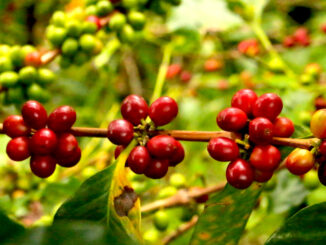
The Mibirizi coffee variety is a true gem of Rwanda, a country often called “the land of a thousand hills.”
This heirloom Arabica coffee reflects the beauty of its homeland — bright, aromatic, and full of character.
Grown in Rwanda’s rich volcanic soil and cared for by smallholder farmers, Mibirizi offers a cup that is both elegant and expressive, a taste of Rwanda’s rising reputation in specialty coffee.
🌍 Origin and History
The Mibirizi coffee variety has deep roots in East Africa.
It is believed to have originated from Burundi, before spreading across the border into southern and western Rwanda.
It was one of the first Arabica varieties introduced to Rwanda in the early 1900s, long before the arrival of Bourbon and other modern cultivars.
Named after the Mibirizi Mission Station in southwestern Rwanda, this variety played a vital role in establishing Rwanda’s coffee culture.
Farmers have cultivated it for generations, maintaining its traditional traits and pure Arabica flavor.
🌿 Variety Characteristics
The Mibirizi variety belongs to the Coffea arabica species, and it shares genetic similarities with Typica and Bourbon, two foundational Arabica lineages.
It’s a tall, strong tree with a graceful structure and elongated cherries.
Key characteristics:
- Species: Coffea arabica
- Tree size: Tall and upright
- Cherries: Medium-sized and elongated
- Bean density: Moderate to high
- Yield: Medium but consistent
- Cup quality: High, with floral and sweet notes
While not as widely planted today as Bourbon or Jackson, Mibirizi remains an important part of Rwanda’s coffee heritage.
🌾 Growing Regions in Rwanda
The Mibirizi variety thrives in Rwanda’s high-altitude regions, where fertile volcanic soil and steady rainfall create ideal growing conditions.
These areas are known for their breathtaking landscapes and meticulous smallholder farming.
Main growing regions include:
- Western Province (Nyamasheke, Rusizi): Near Lake Kivu — rich soil and floral flavor notes.
- Southern Province (Huye, Nyaruguru): Balanced sweetness with tea-like elegance.
- Northern Province (Gakenke, Rulindo): High altitude, bright and citrusy cups.
At altitudes between 1,500 and 2,000 meters, the beans mature slowly, developing complex sugars and refined acidity.
☕ Flavor Profile
The Mibirizi coffee variety is known for its delicate, floral aroma and lively acidity, typical of high-quality East African coffees.
It produces a cup that is sweet, clean, and silky, with layers of fruit and honey-like smoothness.
Typical tasting notes include:
- Floral aroma of jasmine and orange blossom
- Citrus brightness — lemon, mandarin, or grapefruit
- Sweetness of brown sugar or honey
- Fruity tones — red berries or apricot
- Medium body with a clean, tea-like finish
It’s a coffee that feels refreshing and elegant, perfect for those who love clarity and sweetness in their cup.
🌸 Processing and Roasting
Like most Rwandan coffees, Mibirizi is usually washed (wet-processed), a method that enhances its brightness and clarity.
The country’s numerous washing stations have perfected this process, producing consistently clean and vibrant coffee.
Processing steps:
- Hand-picking ripe cherries.
- Pulping and fermenting to remove mucilage.
- Washing with fresh spring water.
- Sun-drying on raised beds for 10–15 days.
Roasting tips:
- Light roast: Brings out floral and citrus brightness.
- Medium roast: Adds sweetness and balance.
- Avoid dark roasts, which mask the delicate aroma.
Mibirizi shines best as a light to medium roast, allowing its natural fruit and floral qualities to come alive.
🌏 Brewing Recommendations
Mibirizi coffee is versatile and performs beautifully across several brewing methods.
Its clean and aromatic nature makes it ideal for slow brewing techniques.
Recommended brewing methods:
- Pour-over (V60 or Kalita): Highlights citrus and floral notes.
- Chemex: Smooth, tea-like body with honey sweetness.
- AeroPress: Balanced and bright with a silky texture.
- Espresso: Sweet and lively, with gentle acidity.
Use medium grind, filtered water, and a temperature around 93°C (199°F) for the best extraction.
🌱 Sustainability and Local Farming
The Mibirizi variety is typically cultivated by smallholder farmers who grow coffee on plots of less than two hectares.
Rwandan farmers use traditional, eco-friendly methods, often without chemical fertilizers.
Sustainable practices include:
- Shade-grown cultivation under native trees.
- Organic composting using natural waste.
- Hand-picking and sun-drying.
- Cooperative farming to ensure fair trade prices.
These community-based efforts preserve both the environment and the authenticity of Rwandan coffee.
❤️ Final Thoughts
Taking a journey through Rwanda with the Mibirizi coffee variety is a journey into tradition, craftsmanship, and pure flavor.
With its floral fragrance, bright acidity, and natural sweetness, Mibirizi embodies the beauty of Rwanda’s coffee culture — humble, proud, and full of heart.
☕ Mibirizi — a Rwandan heirloom that blooms in every cup.
DeliciousPath: Enjoyment in Every Moment
Explore the Gourmet on Board category for exquisite flavors that elevate your meals, even when you’re on a boat, and the Coffee category for aromatic coffee blends that make every moment special. DeliciousPath is here to turn every experience into something unforgettable!
























